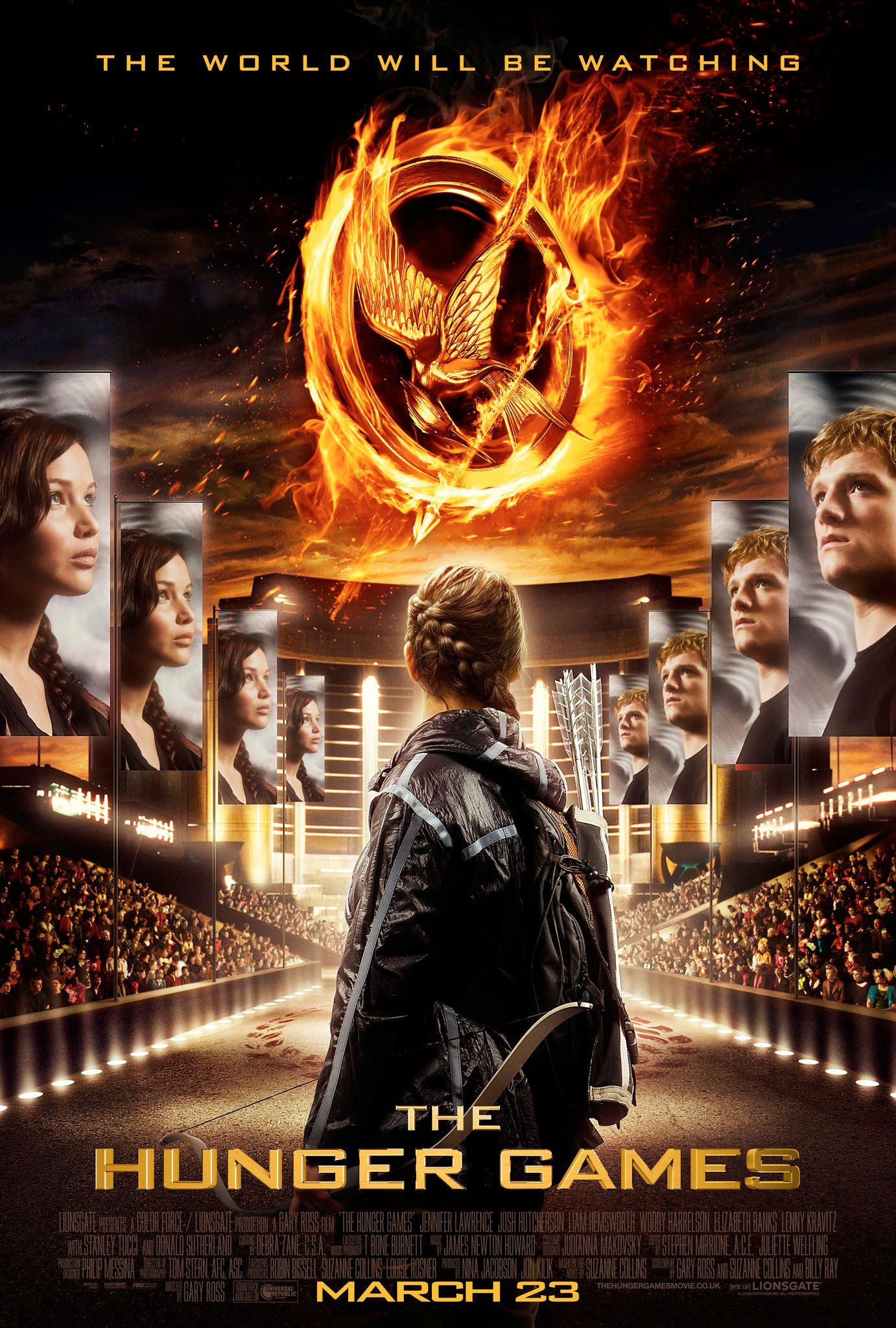The First Hunger Games Movie: Panem's Dark Beginning Unveiled
Step into the chilling world of Panem, a dystopian society where survival is a televised spectacle and rebellion simmers beneath a veneer of opulent cruelty. The first Hunger Games movie, released in 2012, didn't just adapt a bestselling novel; it ignited a global phenomenon, captivating audiences with its stark portrayal of inequality, sacrifice, and the indomitable spirit of a young woman named Katniss Everdeen. This cinematic journey introduced us to a future North America ravaged by war, now known as Panem, a nation divided into a lavish Capitol and twelve impoverished districts, each forced to offer up a tribute to a brutal annual event.
More than just a thrilling action film, The First Hunger Games Movie served as a potent commentary on media manipulation, class struggle, and the human cost of entertainment. Its success wasn't merely due to its gripping plot but also its ability to resonate with universal themes of oppression and hope. As we revisit this seminal film, we delve into what made it such a groundbreaking and enduring piece of cinema, exploring its premise, its unforgettable cast, and the profound impact it had on popular culture.
Table of Contents
- The Genesis of a Phenomenon: Understanding The First Hunger Games Movie
- A Premise Rooted in Despair: The Core Conflict
- The Cast That Brought Panem to Life
- Themes and Social Commentary in The First Hunger Games Movie
- Cinematic Craftsmanship: Directing, Visuals, and Score
- The "Battle Royale" Comparison: Originality vs. Inspiration
- The Enduring Legacy of The First Hunger Games Movie
- Why The First Hunger Games Movie Still Resonates Today
- Conclusion
The Genesis of a Phenomenon: Understanding The First Hunger Games Movie
The journey of *The Hunger Games* from a beloved book to a cinematic juggernaut began with a compelling narrative that resonated deeply with young adult readers and quickly crossed over into mainstream appeal. The first Hunger Games movie, directed by Gary Ross, was tasked with translating Suzanne Collins's grim vision of Panem onto the big screen. Set in a future North America known as Panem, the Capitol selects a boy and a girl between the ages of 12 and 18 from each of the twelve outlying districts to compete in the annual Hunger Games. This isn't just a competition; it's a brutal reminder of the districts' rebellion against the Capitol decades prior, a televised spectacle designed to instill fear and maintain control. The very concept of the Games is designed to be a deterrent, a public display of the Capitol's absolute power, ensuring that no district ever dares to defy them again. The intricate world-building, from the abject poverty of District 12 to the garish extravagance of the Capitol, was meticulously brought to life, creating a stark visual contrast that underscored the story's core themes of inequality and oppression.A Premise Rooted in Despair: The Core Conflict
At its heart, the premise of this movie is very depressing and violent. It revolves around individuals, often referred to as 'tributes,' who are chosen at random to brutally fight to the death, and for the victors, they are rewarded with food and luxury. This barbaric ritual, known as the Hunger Games, is not merely a fight for survival but a deeply disturbing form of entertainment for the Capitol's elite. The film masterfully portrays the psychological toll this system takes, not only on the tributes themselves but also on the citizens of the districts who are forced to watch. The raw emotion and visceral fear that permeate the atmosphere during the Reaping and throughout the Games are palpable, drawing the audience into the harrowing reality of Panem. The violence, though often implied rather than explicitly shown, is nonetheless impactful, emphasizing the sheer desperation and moral decay inherent in the Capitol's regime.The Reaping: A Ceremony of Cruelty
The film's tension builds from its very first moments, leading to the infamous Reaping ceremony. This is a televised competition in which two teenagers from each of the twelve districts of Panem are chosen at random to participate. For District 12, a mining community living on the brink of starvation, the Reaping is a particularly grim affair. The tension is unbearable as names are drawn, a stark reminder of the arbitrary nature of life and death under the Capitol's rule. It is during this moment of collective dread that the true heroism of Katniss Everdeen shines through. When her younger sister, Primrose, is selected, Katniss Everdeen voluntarily takes her younger sister's place in the Hunger Games, a selfless act of love and defiance that immediately sets the tone for her character and the narrative to follow. This pivotal decision, a defiant roar against an unjust system, becomes the catalyst for the entire series, establishing Katniss as the symbol of hope that Panem so desperately needs. Her act of volunteering, a stark contrast to the forced participation, introduces a flicker of agency in a world designed to strip it away.The Cast That Brought Panem to Life
A significant factor in the success of the first Hunger Games movie was its impeccable casting. The film assembled a remarkable ensemble that brought depth and authenticity to their roles. With Stanley Tucci as the flamboyant and unsettling Caesar Flickerman, the Games' host, and Wes Bentley as the enigmatic Head Gamemaker, Seneca Crane, the Capitol's chilling indifference and manipulative nature were perfectly embodied. Tucci's over-the-top performance brilliantly captured the superficiality and cruelty of the Capitol's entertainment culture, while Bentley conveyed the cold, calculating mind behind the arena's deadly designs. Their performances added layers of unsettling realism to the dystopian setting, making the Capitol feel both glamorous and terrifying.Jennifer Lawrence as Katniss Everdeen: A Star is Born
However, the undeniable star of the show, and the anchor of the entire franchise, was Jennifer Lawrence as Katniss Everdeen. Her portrayal was nothing short of phenomenal, capturing Katniss's fierce protectiveness, her vulnerability, and her reluctant emergence as a symbol of rebellion. Lawrence brought a raw authenticity to the character, making Katniss's fear, determination, and moral dilemmas feel incredibly real. Her ability to convey so much through subtle expressions and powerful silences elevated the character beyond a mere action hero, transforming her into a relatable and deeply human protagonist. Her performance was widely acclaimed, cementing her status as a leading actress and arguably being the definitive face of the entire Hunger Games series. The audience felt every arrow she notched, every difficult decision she made, and every spark of hope she ignited.Themes and Social Commentary in The First Hunger Games Movie
Beyond its thrilling action sequences and compelling characters, the first Hunger Games movie is rich with profound social commentary. The film serves as a scathing critique of various societal issues, many of which remain relevant today. At its core, it exposes the stark realities of class disparity, portraying the opulent excess of the Capitol juxtaposed against the grinding poverty and starvation of the districts. This visual and thematic contrast highlights how power and resources are concentrated in the hands of a few, while the majority suffer. Furthermore, the movie delves into the dangers of media manipulation and reality television taken to its extreme. The Hunger Games are not just a competition; they are a meticulously produced, highly sensationalized spectacle designed to entertain and control the masses. The Capitol uses the media to shape narratives, glorify violence, and dehumanize the tributes, turning suffering into entertainment. This mirrors real-world concerns about media ethics, the commodification of human suffering, and the blurring lines between news and entertainment. The film forces viewers to confront uncomfortable questions about their own consumption of media and the narratives they are fed. The psychological warfare waged by the Capitol, through the Games and their media portrayal, is a chilling reflection of how propaganda can be used to maintain oppressive regimes.Cinematic Craftsmanship: Directing, Visuals, and Score
The success of the first Hunger Games movie can also be attributed to its strong cinematic craftsmanship. Gary Ross's direction effectively balanced the grim reality of the Games with moments of raw human emotion. He employed a handheld camera style, particularly in the early scenes in District 12 and during the arena sequences, which immersed the audience directly into Katniss's experience, creating a sense of urgency and vulnerability. This technique made the viewer feel like a participant, not just an observer, in the unfolding drama. The visual design of the film was equally impactful. The stark contrast between the drab, utilitarian aesthetic of the districts and the vibrant, almost absurdly colorful and futuristic look of the Capitol was a powerful visual metaphor for the societal divide. From the Capitol's outlandish fashion to the advanced technology of the arena, every visual element served to reinforce the film's themes. The production design created a world that felt both fantastical and chillingly plausible. Complementing the visuals was James Newton Howard's evocative score. His music perfectly captured the film's shifting moods, from the haunting melodies of District 12 to the pulse-pounding tension of the arena. The score underscored the emotional weight of Katniss's journey, enhancing the suspense, sorrow, and fleeting moments of hope. The combination of strong direction, compelling visuals, and a powerful score ensured that *The First Hunger Games Movie* was not just a story well told, but a visually and aurally immersive experience that left a lasting impression on its audience.The "Battle Royale" Comparison: Originality vs. Inspiration
Upon its release, and even before, the Hunger Games series frequently drew comparisons to Koushun Takami's 1999 novel *Battle Royale* and its 2000 Japanese film adaptation. Seeing the Hunger Games series gain so much recognition is difficult to fathom for some, especially when it's more or less a blatant copy of Battle Royale, a Japanese novel (1996), movie (2000), and manga series. Both narratives feature a dystopian government forcing teenagers to fight to the death in a televised event. The similarities are undeniable, leading to accusations of plagiarism from some corners. However, it's crucial to examine the nuances. While the core premise of a forced death match is shared, the thematic concerns and narrative focus diverge significantly. *Battle Royale* often explores themes of nihilism, the breakdown of social order, and the inherent savagery of human nature when pushed to extremes. *The Hunger Games*, on the other hand, places a stronger emphasis on social commentary, the evils of media manipulation, the corrupting influence of power, and the spark of rebellion against an oppressive system. Katniss Everdeen's journey is less about survival at any cost and more about maintaining humanity and inspiring hope. The political backdrop, the specific rules of the Games (e.g., sponsors, muttations), and the development of the rebellion are unique to *The Hunger Games*. Suzanne Collins herself has stated that her inspiration came from channel surfing between reality television and news coverage of war, leading to the idea of entertainment and violence merging. While influences in storytelling are common, *The Hunger Games* managed to carve out its own distinct identity and resonate with a global audience due to its unique character development, rich world-building, and potent social critique that went beyond the basic premise. It took a familiar concept and infused it with its own distinct purpose and emotional depth.The Enduring Legacy of The First Hunger Games Movie
The first Hunger Games movie didn't just spawn a successful film franchise; it left an indelible mark on popular culture and the young adult dystopian genre. Its success paved the way for numerous other dystopian adaptations and original stories, cementing the genre's commercial viability. The film also sparked countless discussions about social inequality, political oppression, and the ethics of media, proving that blockbuster entertainment could also be intellectually stimulating. It demonstrated the power of a strong female protagonist, inspiring a new generation of heroines in cinema. The imagery of the Mockingjay, Katniss's symbol, became an icon of rebellion, transcending the confines of the film itself.Expanding the Universe: Prequels and Future Prospects
The rich world of Panem continues to expand, proving the lasting appeal of the franchise. *The Ballad of Songbirds & Snakes*, a prequel novel by Suzanne Collins, was adapted into a film in 2023, delving into the origins of the Hunger Games and the early life of Coriolanus Snow. This film, featuring new talents like Dexter Sol Ansell, Rosa Gotzler, Clemens Schick, and Fionnula Flanagan, provided a deeper understanding of the Capitol's history and the evolution of the Games, connecting back to the foundational elements established in the first Hunger Games movie. Looking ahead, the Panem universe is set to grow even further. News of a new book and film adaptation, *Sunrise on the Reaping 2026*, explores Panem 24 years before Katniss' saga, starting on the morning of the Reaping for the 50th Hunger Games, where a young Haymitch Abernathy (Katniss's future mentor) is a tribute. This continuous expansion underscores the enduring fascination with Panem's dark history and the characters who inhabit it, ensuring that the legacy of *The Hunger Games* remains vibrant and relevant for years to come.Why The First Hunger Games Movie Still Resonates Today
Even over a decade after its release, the first Hunger Games movie continues to resonate with audiences for several compelling reasons. Its themes of social injustice, government control, and the fight for individual freedom are timeless and remain acutely relevant in our contemporary world. The film's depiction of a society where entertainment is used as a tool of oppression feels eerily prescient, prompting viewers to critically examine their own media consumption and political landscapes. Furthermore, Katniss Everdeen remains an iconic and relatable protagonist. Her journey from a reluctant tribute to a symbol of hope embodies the universal struggle against overwhelming odds. Her courage, resilience, and unwavering loyalty to her loved ones make her a character that audiences can cheer for and connect with on a deeply emotional level. The film's ability to combine thrilling action with profound emotional depth ensures its lasting impact. It's not just a story about survival; it's a story about the enduring power of humanity in the face of dehumanization, making *The First Hunger Games Movie* a significant and enduring piece of modern cinema.Conclusion
The first Hunger Games movie was more than just a successful adaptation; it was a cultural touchstone that redefined the young adult dystopian genre and left an indelible mark on cinematic history. From its chilling premise and unforgettable characters to its profound social commentary and groundbreaking visual style, the film masterfully brought Suzanne Collins's Panem to life. It introduced us to the indomitable spirit of Katniss Everdeen, a character who bravely volunteered for her sister, and ignited a spark of rebellion that continues to inspire. As we look back at its enduring legacy, it's clear that *The First Hunger Games Movie* remains a powerful and relevant piece of cinema, reminding us of the dangers of unchecked power and the resilience of the human spirit. What were your most memorable moments from the film, and how do you think it shaped the dystopian genre? Share your thoughts in the comments below, and if you enjoyed this deep dive, be sure to explore our other articles on the expanding world of Panem!


Detail Author:
- Name : Luciano Davis
- Username : benjamin82
- Email : emard.harmon@runte.net
- Birthdate : 1976-01-08
- Address : 481 Boyer Points Suite 669 West Herminio, TX 92891
- Phone : 815-859-5165
- Company : Sanford-Olson
- Job : Soil Conservationist
- Bio : Architecto incidunt magnam sit nisi et ut consequatur. Sit molestiae qui est nihil.
Socials
twitter:
- url : https://twitter.com/clementinelang
- username : clementinelang
- bio : Et quia dolores omnis soluta omnis aut. Atque ea officia hic minima. Veniam id aperiam quisquam dolore. Et quod dolor quisquam id occaecati itaque.
- followers : 4520
- following : 2292
linkedin:
- url : https://linkedin.com/in/clementine_lang
- username : clementine_lang
- bio : Aut at laborum enim qui commodi facere.
- followers : 3830
- following : 862
facebook:
- url : https://facebook.com/lang2011
- username : lang2011
- bio : Architecto qui voluptatem enim quo et aut.
- followers : 5802
- following : 2060
instagram:
- url : https://instagram.com/clementine.lang
- username : clementine.lang
- bio : Eius quibusdam et est dicta ex. Dicta voluptas qui magni harum quia itaque vitae.
- followers : 2535
- following : 148
tiktok:
- url : https://tiktok.com/@clementine.lang
- username : clementine.lang
- bio : Magni blanditiis et et aperiam atque consectetur voluptates.
- followers : 4900
- following : 854
